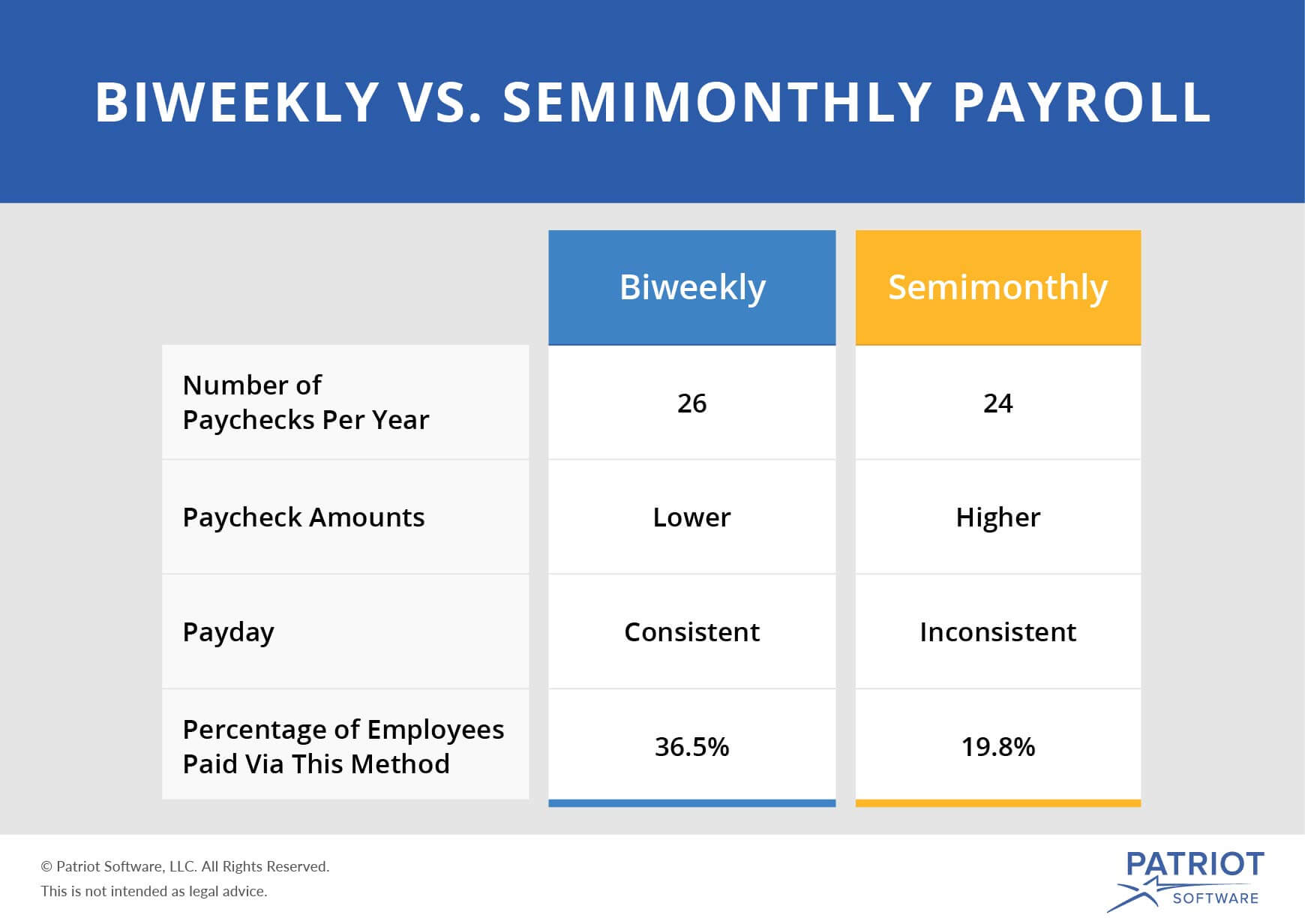Payroll
The Pros and Cons: Biweekly vs. Semimonthly Payroll
Deciding on a pay frequency for your small business is an important decision. Your pay frequency determines how often you process payroll and when employees receive their paychecks. Two popular, yet easily confused, pay periods are biweekly and ...
Oct. 15, 2018

Deciding on a pay frequency for a small business is an important decision. Pay frequency determines how often the business must process payroll and when employees receive their paychecks. There are four common pay period options, including weekly, biweekly, semimonthly, and monthly. Two popular, yet easily confused, pay periods are biweekly and semimonthly. Knowing the difference between biweekly vs. semimonthly payroll can prevent financial setbacks, keep the business legally compliant, and more.
Biweekly and semimonthly can be confusing because employees generally receive two payments per month. However, there’s more to these pay periods than meets the eye.
Number of paychecks per year
With a biweekly pay schedule, there are two months in the year where employees receive three paychecks. Employees who are paid semimonthly always receive two paychecks per month. Companies that run payroll with a biweekly frequency dole out a total of 26 paychecks per year. Companies that use semimonthly pay give employees 24 paychecks per year.
Paycheck amounts
Because the payroll is processed fewer times for semimonthly frequencies than biweekly, employees’ paychecks will be greater. Biweekly paychecks will be be for less money, but employees will receive the two additional paychecks to make up the difference.
Let’s say an employee makes $42,000.00 per year. If they are paid biweekly, their gross wages would be approximately $1,615.38 every other week ($42,000.00 / 26). If they are paid semimonthly, their gross wages would be $1,750.00 ($42,000.00 / 24). Over the course of a year, the employee will receive the same amount of money and owe the same amount of taxes, regardless of which payment frequency you use.
Payday
Another difference between semimonthly vs. biweekly pay is what day of the week you run payroll and which day employees receive their paychecks. If the payroll is run biweekly, employees receive their wages the same day each pay period. For example, employees will be consistently paid every other Friday, so the payroll is run on the same day each pay period. With semimonthly payroll, the employees are paid on specific dates, such as the 15th and last weekday of each month. As a result, the days of the week will differ: An employee might get paid on a Friday and Tuesday.
Popularity
Biweekly payroll is the most popular payment option. According to the Bureau of Labor Statistics, 36.5% of employees are paid biweekly. On the other hand, only 19.8% of employees are paid using the semimonthly payroll frequency.
Choosing between semimonthly vs. biweekly payroll
Deciding between biweekly vs. semimonthly payroll can be a difficult decision, especially because federal pay laws state that businesses must keep the same frequency throughout the year. Before choosing, keep in mind that states regulate how often employees must be paid and some states may not allow ceretain pay frequencies. Businesses should check with their state before choosing how often to run payroll.
Cons of running a semimonthly payroll
First, consider how many employees there are and which ones are hourly or salaried. Running a semimonthly payroll for hourly employees is more difficult and confusing than doing so for salaried employees, especially when workers earn overtime pay. To combat this, it may be beneficial to process payroll semimonthly for salaried employees and biweekly for hourly workers.
The lack of consistency with semimonthly payroll can also be a turnoff for some businesses and employees. Since payroll will be processed on a different day of the week, the person running payroll could lose track of that responsibility. Also, employees might not be sure which day they get paid. Running semimonthly payroll can be particularly difficult to track when weekends and holidays come into play. If payday falls on a holiday or weekend, te payroll will either need to be paid in advance or delayed through the weekend or holiday, adding another factor to the processing duties.
Cons of running a biweekly payroll
There are setbacks to running biweekly payroll, too. When employees are paid semimonthly, salaried workers receive the same amount to employees each month. The extra two paychecks for biweekly pay frequencies can make budgeting more challenging if the business doesn’t properly prepare for months with three paychecks. The business needs to make sure it has enough money in its payroll account to cover the additional expenses.
For instance: A business with 10 employees who each earn $1,500 in gross wages per paycheck. In months with three paychecks, the business will need to have an additional $15,000 on hand.
Also, keep in mind that some payroll providers charge the business for each payroll run, which can result in higher annual costs for those who process payroll biweekly compared to semimonthly. The business may consider choosing a provider that allows unlimited payroll runs, regardless of frequency.
========
Rachel Blakely-Gray is a writer for Patriot Software, a provider of payroll and human resources management solutions for small businesses.
